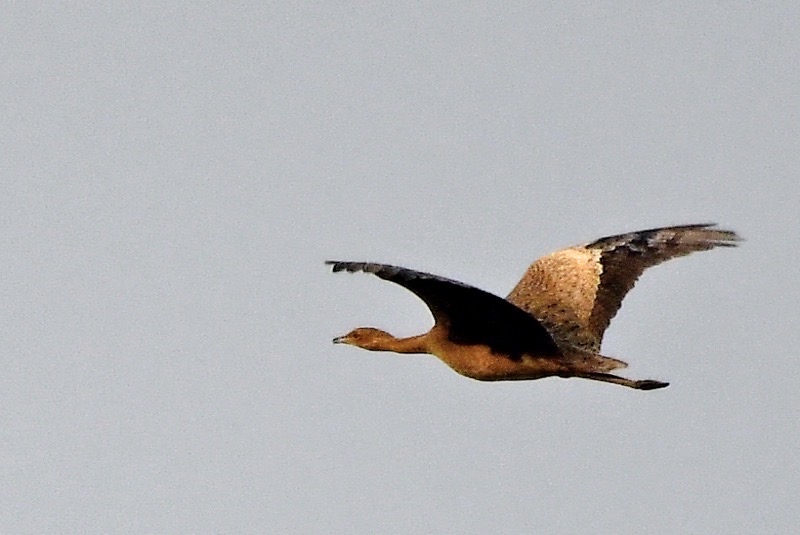According to scientists, a dainty bustard might serve as a model flagship species for riverine grasslands in North and Northeast India. It is a typical or indicator species of dry grasslands in the Brahmaputra and Ganga rivers, and its existence signals a healthy grassland ecosystem; nonetheless, the species, under threat on several fronts, is rapidly vanishing.
The Bengal florican (Houbaropsis bengalensis), commonly known as the Bengal bustard, is a bustard species found in India, Cambodia, and Vietnam. The IUCN Red List classifies it as Critically Endangered because less than 1,000 individuals are alive.
National and local conservation organisations are working to raise awareness and implement measures to preserve the species from hunting and habitat degradation. However, government funds and resources are made scarcely available.
Bengal Floricans are usually hard to spot. They are medium-sized ground birds, approximately 60 cm tall when standing. It has obvious sexual dimorphism. Males are black with speckled brown back and white wings, while females have complex buffy brown patterns all over. Males have a large cluster of feathers hanging under the breast during the mating season.
The Bengal Floricans are rarely seen outside of the mating season, which starts in February and lasts till early July. During this time, the male’s spectacular jumping display flight regularly puts it above the grasses and into view. The male’s black and white plumage is shown off to fine advantage in short arching display flights and coordinated strutting—with fluffed-up neck feathers and a head pumping movement—to attract females.
These birds are omnivorous and eat a variety of seeds, grains, fragile grass shoots, and insects such as grasshoppers, ants, beetles, and even frogs. They have been observed consuming burned seeds in scorched regions.
The Bengal Floricans are the lone members of the genus Houbaropsis and the most uncommon member of the Bustard Order, Ortidiformes. Two-thirds of the worldwide population breeds in Cambodia’s Tonle Sap Lake floodplain; they move up to 100km yearly to avoid the floodwaters during the non-breeding season.
Thousands of kilometres distant, in Nepal and India, another population of the same species lives in the duars and terai grasslands at the foot of the Himalayas.
These Floricans can be found in Uttar Pradesh, Dudhwa and Pilibhit Tiger Reserve at the Ganga floodplains in India. The species can also be found in the Brahmaputra delta’s Jaldapara National Park in West Bengal, Kaziranga and Manas National Parks in Assam and D’Ering Wildlife Sanctuary in Arunachal Pradesh.
They are also present in several unprotected settings, including islands in the Brahmaputra River and agricultural areas next to protected grasslands in both Northeast India and Uttar Pradesh. According to a new study, some living in these settings may have gone undiscovered thus far.
Most populations in South Asia are tiny, isolated, and at risk of extinction. The main threats are extensive grassland loss and modification due to drainage, conversion to agriculture and plantations, overgrazing, inappropriate cutting, burning, and ploughing regimes, heavy flooding, alien species invasion, shrub expansion, dam construction, and inappropriate and illegal development.
They were hunted for sport and food, contributing to their near-extinction status. According to the IUCN Red List, the decreasing trend has lately accelerated and is expected to continue in the future.
A Darwin Initiative study was launched in 2012 to investigate the species’ range and ecological needs in India and Nepal. Three males were satellite-tagged in India in 2014, followed by one more later.
Conservationists identified significant locations for the species and recommended appropriate management regimes as a consequence of the tagging effort. Trial habitat plots have also been developed to understand habitat preferences further.
Several potential habitats of Bengal floricans were identified, particularly in unprotected riverine islands and grasslands. Some of the identified habitats are problematic as the Ganga and Brahmaputra delta, being fertile regions, are prone to converting the grasslands to agricultural fields. Intensive farming and pesticide use make the agricultural areas uninhabitable for these birds as they can’t find food due to the loss of insects.
On February 15, 2020, government officials, scientists, and conservationists from 130 nations convened in Gandhinagar, Gujarat, for the 13th Conference of Parties (CoP) for the Convention on Migratory Species (CMS). The CoP assessed the status of migratory birds and animals throughout the world and determined which birds and animals require increased protection and international cooperation to promote their freedom of movement as they migrate between breeding and wintering areas. One of the birds on the proposed list was the Bengal Florican.
The Bengal Florican had barely gained any attention in comparison to other bustards like the Great Indian Bustard. This is partly due to the fact that the species is not very popular. However, a newly revived effort to study the species and the dangers it faces, together with the CMS proposal, gives experts optimism for its future.
There are difficulties in tracking the populations of the Bengal Florican. According to Rohit Jha, a researcher from the Wildlife Institute of India, the uncertainty regarding the population is due to the trouble of spotting them.
“It is extremely difficult to see the bird, thereby requiring many hours of patience and practice,” said Jha. The birds become somewhat visible during the breeding season. Since Ganga and Brahmaputra are prone to flooding, grasslands become inaccessible.
While there was a lack of attention by the state governments, the bird was receiving some attention from the local forest departments. However, the main concern for the conservationists was the lack of funds. The senior ornithologist emphasised the necessity of researching Bengal Florican migration during non-breeding seasons, and Movement studies have proven critical in building the case for the species’ protection under the CMS.
The 13th Conference of Parties to the Convention on Migratory Species (CMS) overwhelmingly adopted the Indian government’s proposal to add the Bengal Florican in Appendix 1 of the CMS on February 20. Based on new findings, as the Bengal Floricans travelled between India, Nepal, and Bhutan during the non-breeding season, the Indian delegation pushed the member nations to approve the idea.
“It will be extremely beneficial for the Bengal Florican and increase collaboration with Nepal and Bhutan,” said Girish Jathar of the Bombay Natural History Society (BNHS). He is one of many involved in preparing the proposal for CMS. Jathar feels that the action will assist conservationists and managers in raising additional money from the Government of India and other international organisations for research and management of the Bengal Florican.
The COP also approved the proposal to add the Great Indian Bustard in CMS Appendix 1.
-30-
Copyright©Madras Courier, All Rights Reserved. You may share using our article tools. Please don't cut articles from madrascourier.com and redistribute by email, post to the web, mobile phone or social media.Please send in your feed back and comments to editor@madrascourier.com











